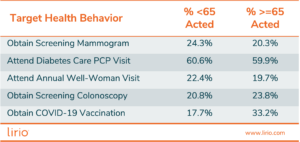“For a just selection, everybody has to take the same exam: climb that tree.” In this well-known satire of the education system, it matters a tremendous amount on your selection success whether you’re a dog, a seal, a goldfish, or a monkey.
In healthcare, the cartoon might look like this:
Age and Health Equity
According to the American Public Health Association (APHA), adults over age 65 will outnumber children in the United States by 2034. The growth of the older segment is attributable to innovations in medicine and public health as well as corrections to historical social determinants of health, but unfortunately, these improvements were not experienced evenly across subpopulations. There remain deeply rooted health inequities. Older adults from marginalized communities, such as racial and ethnic minorities, LGBTQ+ individuals, and those living in poverty, are more likely to experience poor health outcomes and have reduced access to healthcare services. It matters for your health whether you’re a goldfish, an elephant, a cat, a frog, or a seagull.
Health equity means that every person has the opportunity to “attain his or her full health potential” (Centers for Disease Control and Prevention, 2022). To achieve health equity requires multifaceted approaches that involve addressing social and economic inequalities, tackling racism and discrimination, improving access to healthcare services, and addressing educational and cultural barriers to health.
Addressing Behavioral Determinants Relevant to Underserved Populations
In our digital health interventions, we address myriad behavioral determinants – barriers and facilitators of a target health behavior like obtaining a flu vaccine. We place particular emphasis during the behavioral design process on ensuring that behavioral determinants relevant to underserved populations like the elderly are broadly addressed. We also leverage reinforcement learning to personalize data-driven decisions like health campaign prioritization, send time, and channel, to reach each individual more effectively.
People Aged 65 and Above Show Similar Engagement and Achievement with Digital Health Interventions
 In pilot studies to increase adherence with recommended target health behaviors such as obtaining screening mammograms we find evidence that when the behavioral determinants addressed are more inclusive, and when message content is targeted appropriately, people of different backgrounds have similar levels of engagement and achievement of the targeted health behaviors.
In pilot studies to increase adherence with recommended target health behaviors such as obtaining screening mammograms we find evidence that when the behavioral determinants addressed are more inclusive, and when message content is targeted appropriately, people of different backgrounds have similar levels of engagement and achievement of the targeted health behaviors.
Engagement means interacting in some way with the messaging, be it opening it and/or clicking links and Calls-to-Action. Despite the many stereotypes surrounding people aged 65 and above and their use of technology, five different target behaviors that support health outcomes we find similar levels of engagement for people aged 65 and above as for those aged below 65.
 Acting means completing the target health behavior, for example scheduling and then attending the screening mammogram. When we look at the five different target behaviors that impact health outcomes, we find that people aged above 65 on average act similar to those under age 65, with variation across the five target health behaviors. We see equitable health outcomes for those aged 65 and above on many target health behaviors and consider it our duty to investigate how we can continue to drive equity for this group.
Acting means completing the target health behavior, for example scheduling and then attending the screening mammogram. When we look at the five different target behaviors that impact health outcomes, we find that people aged above 65 on average act similar to those under age 65, with variation across the five target health behaviors. We see equitable health outcomes for those aged 65 and above on many target health behaviors and consider it our duty to investigate how we can continue to drive equity for this group.
Marrying Behavioral Science and Reinforcement Learning to Drive Equitable Health Outcomes
We leverage behavioral science and reinforcement learning to drive inclusive outreach and equitable health outcomes. Our intervention, Precision Nudging, uses a type of artificial intelligence (AI) called behavioral reinforcement learning (BRL). The BRL chooses message components from a library of behavioral science content specifically crafted to address the behavioral determinants that have been identified in research as reasons why people may delay or avoid health behaviors. The BRL also selects the best timing for each individual, the channel, and prioritizes the next best health behavior.
Our behavioral design process intentionally includes research on traditionally underserved populations, such as the elderly, racial and ethnic minorities and people with lower incomes or educational attainment. The behavior change techniques best suited to address the behavioral determinants experienced by these groups are included in the intervention content for BRL selection.
Moving people to recommended screenings and annual visits advances individual as well as foundational population health goals. By including the right “ingredients” to meet a diverse set of needs and by effectively personalizing the content each individual sees based on their own reactions, Precision Nudging can effectively improve health equity by matching each individual to the right behavioral approach.

